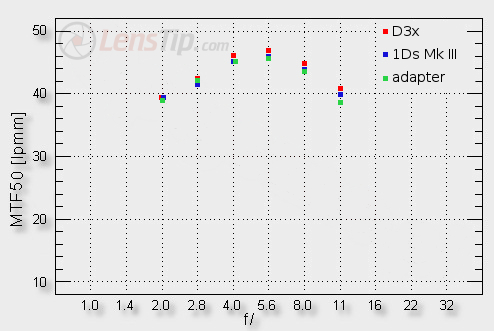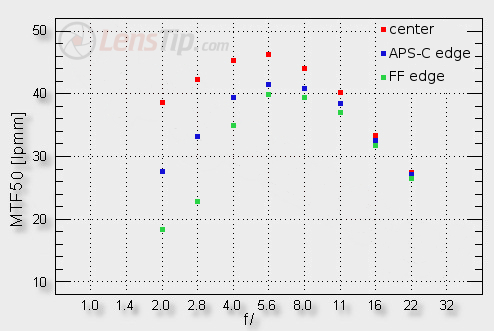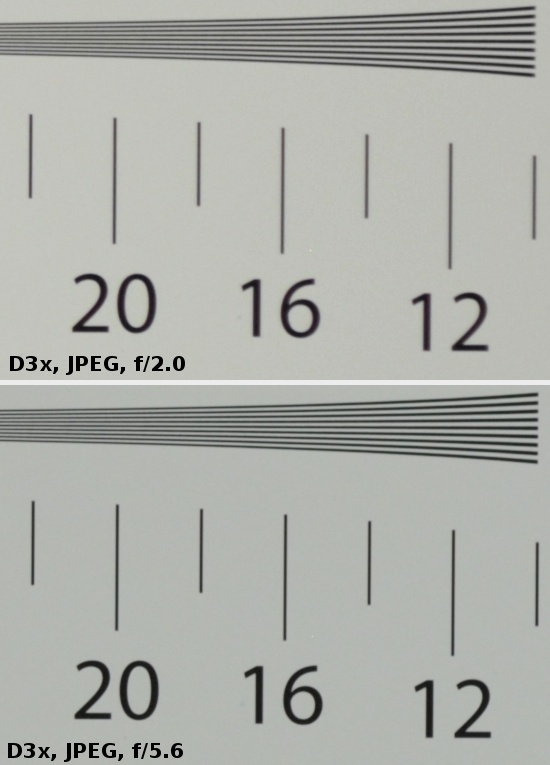Carl Zeiss Makro-Planar T* 50 mm f/2 ZF/ZK/ZE
4. Image resolution
As part of extending and improving our editorial equipment we decided to buy a high quality manual lens which not only allows you to get very precise settings but also is very well build, durable and available in many mount versions. At first we were thinking of the Carl Zeiss Planar T* 50ámm f/1.4 ZF/ZK/ZE. Our test of that instrument, conducted on the Nikon D200, showed that the lens, after stopping down to near f/4.0-f/5.6, can generate ones of the sharpest images we have been able to get on a sensor of this type so far. Our editorial office was sent the ZE and the ZF.2 models; unfortunately we had problems with obtaining the Pentax mount version (ZK), which couldn’t be found either in the Polish distributor or in the Zeiss main depot. While looking for that specimen we got the information that the main depot still had in stock the Carl Zeiss Macro-Planar T* 50ámm f/2 ZF/ZK/ZE so in all mount versions. We knew that, as a macro lenses, they are much more complex constructions than the classic Planars and they can reach often record-breaking resolution values so we asked to send them to our office. We could perform their full test based on two full frame bodies we ordinary use while testing optics so the Canon 1DsáMkIII and the NikonáD3x
Before we progressed to our classic test procedure we made a certain comparison. We knew that the MTFs you get on the 1Ds MkIII and the D3x are very similar to each other. The best lenses, tested on these bodies reach maximum results near 45-47 lpmm and the decency level was set at 30-32 lpmm. Now, having the same optical construction but with two different mounts we could compare their performance even more directly. Of course we needed to assume that the quality of those two specimen didn’t differ much and we did what we could to ensure the lenses were equally good. For example we managed to get two ZE mount lenses (and their resolution values differed just slightly) and the ZF.2 lens we attached to the D3x and to the 1Ds MkIII using a special adapter.
Please Support UsIf you enjoy our reviews and articles, and you want us to continue our work please, support our website by donating through PayPal. The funds are going to be used for paying our editorial team, renting servers, and equipping our testing studio; only that way we will be able to continue providing you interesting content for free. |
- - - - - - - - - - - - - - - - - - - - - - - - - - - - - - - - - - - - - - - - - - - - - - - -
Before we present the results of that experiment I must also write something about adapters as this topic kept emerging in discussions under our tests or on our forum. Why do I prefer one and the same type of lens but with different mounts, instead of having one lens and different adapters for different bodies? The first reason is connected with the fact that, in order to attach one and the same lens to all the systems, available on the market, sometimes I would have to use adapters with additional optics which contributes to the worsening of the final performance. Fortunately that problem doesn’t concern an adapter which allows you to attach lenses with the Nikon (F) mount to the Canon (EF) bodies. The second reason is the build quality of those adapters. Very often they are responsible for slanting the optical axis of a lens to a wrong angle which results in errors. It is not my imagination – that fact was confirmed by testing initially several of such adapters. Also in this test an adapter, used in our experiment, didn’t allow to reach record values – the results we got with it were a tad worse than the rest.
Let’s get down to facts now. The graph below presents MTF50 function values, depending on the aperture, we got in the frame centre on our biggest testing chart for three systems. The first system consisted of the Canon EOSá1DsáMkIII joined with the Carl Zeiss Makro-Planar T* 50ámm f/2áZE; the second one was the Nikon D3x with the Carl Zeiss Makro-Planar T* 50ámm f/2 ZF.2 lens and the third system was the Canon EOS 1Ds MkIII plus an adapter and the Carl Zeiss Makro-Planar T* 50ámm f/2 ZF.2.

It can be clearly seen that by f/2.0 and f/2.8 the performance of the three systems is practically identical. After a more significant stopping down the ZF.2 model attached to the D3x fares the best, with the ZE on the 1Ds MkIII immediately behind. The system with the adapter is the worst. Still it should be noticed that the differences here are really slight, usually not higher than of 1-2 lpmm. Taking into account the fact that the typical measurement errors are on the level of 0.5-1.0 lpmm the results in most cases are similar and interlocking, even 1-sigma level so from the statistical point of view you still can’t say that one system is noticeably better than the other.
As it was proven that there are no measurable differences between the tests performed on 1DsáMkIII and theáD3x we can progress to a classic lens test, conducted using not one but three testing charts of different sizes, with the lens being positioned in three different distances from its aim. For a full resolution test we chose the ZF.2 model attached to the Nikon D3x. The results we got are presented on the graph shown below.

The performance at the maximum relative aperture, where the lens reaches over 38 lpmm, sticks out immediately. It is worth noticing that by f/2.0 the Makro-Planar is still a bit sharper than the ordinary Planar 1.4/50 which by f/2.0 is already stopped down one EV stop. It is really a performance worth emphasizing. On further stopping down the Macro-Planar performs brilliantly. The maximum results, reached by f/4.0 and f/5.6, are hovering around 46 lpmm – close to record-breaking values.
On the edge of the frame the situation is not so perfect any longer. The maximum relative aperture disappoints a bit because it is not fully useful even on the edge of the APS-C/DX sensor. Fortunately the situation improves very swiftly on stopping down. On the edge of the smaller detector the usefulness is reached near f/2.5 and on the edge of full frame – near f/3.5. Overall it is not a bad result – you can remind yourself here of the performance of the faster Nikkor AF-S 50 mm f/1.4G, which, already on the edge of full frame and by almost all apertures had worse results than the Zeiss, tested here.
Below we present crops taken from photos of our resolution testing chart which we saved as non-sharpened JPEG files along with RAW files, used for the analysis below.
 |






